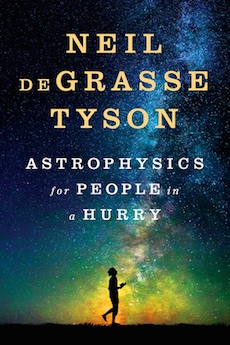By Jay M. Pasachoff
The joke among us astrophysicists is that on a long plane flight you want to talk to your seatmate, you say you are an astronomer, but if you don’t want to talk, you say you are an astrophysicist. Neil Tyson is ruining that ploy by making contemporary astrophysics so accessible to the general reader.
His pocket-size volume has brought the good word on how interesting today’s astrophysics is to the general public, even reaching first place on The New York Times’s best seller list. In twelve chapters—updated in some way and in some places from a series of essays he wrote for the monthly Natural History Magazine—he takes us in chronological order from (without using the prefixes) the first yocto-/zepto-/atto-/femto-/pico-/nano-/micro-/milli, and other tiny fractions of time after the Big Bang some 13.8 billion years ago first through the formation of hydrogen and then through the release of the Cosmic Background Radiation that now permeates space at a temperature of—he gives us permission to round it—3° above absolute zero.
The first half of the book (chapters one through six) take us from the very early and the very small through the expansion of the Universe. We learn how dark matter makes up more of our ordinary matter than the type that we can see, and how dark energy is the term for the unknown force that is accelerating our Universe’s expansion.
The second half of the book takes us from the formation of heavy elements like iron through the formation of round objects like stars and planets. We learn how our senses were expanded first by William Herschel finding that a thermometer beyond the red end of a spectrum still showed an increased temperature—the discovery of “infrared,” followed by the extension of our eye’s spectrum beyond the violet, “ultraviolet.”
We learn about whatever is between the planets, including asteroids (12123 is named Tyson) and the planets’ moons. He sets the stage for the analysis of planets around other stars, now known as exoplanets, by discussing the planetary character of our Earth. (But would we, as he said he would, have to admit in answer to a question that “alien life forms from” Jupiter’s moon Europa—should there be any—could be known as Europeans? My wife points out that maybe the life forms, if sufficiently intelligent, would have their own names for themselves, not ones provided by Earthlings. Though it isn’t discussed in the book, the names for the Galilean satellites Io, Europa, Ganymede, and Callisto were bestowed in 1614 by Simon Marius, who discovered these moons independently one day after Galileo in early 1610 by the Gregorian calendar, adopting a suggestion by Johannes Kepler.)
After the survey of astrophysics, I was surprised by the humanity shown in the final chapter, “Reflections on the Cosmic Perspective.” I was surprised and pleased to read: “When I pause and reflect on our expanding universe, with its galaxies hurtling away from one another, embedded within the ever-stretching, four-dimensional fabric of space and time, sometimes I forget that uncounted people walk this Earth without food or shelter, and that children are disproportionately represented among them.” After a litany of things that are all too easy to forget, he concludes: “I occasionally forget these things because, however big the world is…the universe is even bigger. A depressing thought to some, but a liberating thought to me.”
We would all benefit from reading Tyson’s flowing and often casual prose to understand and appreciate our place in the Universe, as seen from our perch in 2017.
Astronomer and author Jay Pasachoff is the director of Hopkins Observatory and Field Memorial Professor of Astronomy at Williams College.




